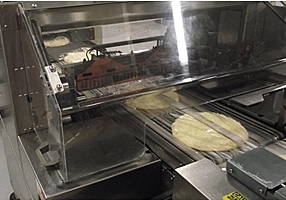 Frozen pizza remains one of the most ubiquitous foods in the typical American household. Convenience, low price and a continually growing assortment of options have made frozen pizza a favorite heat-and-serve choice for households constrained by time and budgets.
Frozen pizza remains one of the most ubiquitous foods in the typical American household. Convenience, low price and a continually growing assortment of options have made frozen pizza a favorite heat-and-serve choice for households constrained by time and budgets.According to the American Frozen Food Institute (AFFI), McLean, Va., 66% of households in the United States consumed frozen pizza in 2010. With total sales reaching $3.2 billion in that year, this accounts for almost 10% of U.S. mass-market frozen food sales. In fact, the United States is the largest frozen pizza market in the world, representing approximately 43% of global market value.
Shrink wrapping challenge
Keeping up with the demand for this very popular consumer product can be a challenge for food processors. Not only because of the high throughputs required, but because frozen pizza can be a difficult product to package. Few frozen food products require more careful handling through the packaging process than pizza. And nowhere in the packaging cycle is this more critical than in shrink wrapping.
Automated shrink wrapping of frozen pizzas has long presented significant challenges for food processors. Delicate handling of these frozen pizza pies is required to keep the sauce and loose toppings like pepperoni, mushrooms, sausage and cheese intact during wrapping. These ingredients tend to shift around and fall to the bottom of the shrink bag before sealing.
Additionally, frozen pizza being a low profile product has a high capability for shingling while traveling back-to-back on the infeed conveyor before entering the wrapper. Shingling prompts poor infeed registration, resulting in missed flights, double product bagging and broken crust. When running at high speeds, such as 100 pizzas per minute, most infeed systems cannot consistently maintain accurate indexing with the shrink wrapper.
The conventional machinery employed for high-speed shrink wrapping of frozen pizzas—at the rate of 100-150 pizzas per minute—typically uses lap seal technology for sealing the shrink bag. The lap seal method wraps the film around the pizza as it goes through a forming shoe, then it overlaps the film on the bottom of the pizza, static sealing it before going into the shrink tunnel. A key problem with this sealing method is that pizza toppings will frequently fall underneath where the seal is being made and compromise the integrity of the seal. When the wrapped pizza comes out of the tunnel, the lap seal can be loose or open, but it is very hard to detect. Usually it is the customer who discovers that the pizza they purchased has not been securely sealed.
To achieve a better quality seal on frozen pizzas, food processors have utilized continuous motion side-seal shrink wrappers. These systems allow a continuous incoming stream of pizzas through the wrapper while a side-seal is generated, followed by an end seal that separates each package before entering the shrink tunnel. Because the seal is being formed on the edge of the pizza rather than across the bottom, the danger of loose toppings contaminating the seal area is eliminated, resulting in a much more reliably sealed package.
Conventional continuous side-seal wrappers, however have a limited speed range. They are useful up to about 100 pizzas per minute throughput—above that and their quality output diminishes. Consequently, many frozen pizza producers have opted for lap seal wrappers to achieve the higher throughput, despite the loss in seal quality.
Palermo’s Pizza’s high-speed, side-seal wrapper line
Now, a new generation of continuous motion side-seal shrink wrapper for frozen pizzas provides the benefits of a secure seal combined with a high-throughput capability. Palermo’s Pizza is one frozen pizza manufacturer that is utilizing this latest continuous side-sealing technology.
Based in Milwaukee, Wis., Palermo’s Pizza was started by Sicilian immigrants Gaspare and Zina Fallucca, who opened an Italian bakery on Milwaukee’s east side in 1964. The bakery expanded into a full-service restaurant known for its pizza, and by 1979, they began to manufacture and sell frozen pizzas based on their family’s traditional Sicilian recipes.
Palermo's is an innovator in the frozen pizza category, creating what is said to be the industry's first self-rising frozen pizza and its first ultra-thin crust product. It manufactures a family of frozen pizzas under the Palermo’s brand, including products such as Primo Thin, Naturally Rising, Stone Baked and Classics by Palermo’s. The company continues to research and develop new products and flavors that cater to consumer needs, such as its recent introduction, Palermo’s Hand Tossed Style, which features “family-favorite flavors” on a middle-thickness crust.
The popularity of these brands has made Palermo’s one of the fastest growing manufacturers of frozen pizzas in the United States. To meet the demand for its products, the company recently expanded its headquarters and manufacturing facility. Opened in 2011, its new 250,000-square-foot state-of-the-art, USDA-certified manufacturing plant is a showpiece of packaging technology, operating four packaging lines for handling its frozen pizzas. But, central to Palermo’s packaging operation is its main packaging line for handling its top-selling 12-inch frozen pizzas.
Prior to reaching that packaging line, sauce and toppings are deposited onto dough to form the pizzas, which are then put through an ammonia-based spiral freezer. Exiting the freezer, the now frozen pizzas are conveyed through the shrink wrapper and shrink tunnel, then on to labeling and cartoning. The product is then cased, palletized and sent off to shipping or deep freeze storage.





